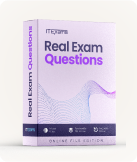Test Prep NAPLEX - North American Pharmacist Licensure Examination Exam
Page: 1 / 31
Total 154 questions
Question #1 (Topic: Topic 1)
Which of the following represents the major route of metabolism for acetaminophen?
A. Glucuronidation
B. Sulfation
C. Cytochrome P-450 oxidation
D. Direct renal excretion
E. Plasma breakdown
Answer: A
Question #2 (Topic: Topic 1)
A 15-year-old presents with 6 days of nasal congestion with thin, clear rhinorrhea. She notes mild facial pain but has had no fevers. She feels her symptoms are
improving.
What is the most likely cause of her symptoms?
improving.
What is the most likely cause of her symptoms?
A. Streptococcus pneumoniae
B. Viral
C. Moraxella catarrhalis
D. Haemophilus influenzae
E. Staphylococcus aureus
Answer: B
Question #3 (Topic: Topic 1)
A 72-year-old woman suffers from a major depressive episode. She has a history of coronary artery disease, atrial fibrillation on anticoagulation therapy, sick sinus
syndrome, glaucoma, and chronic obstructive pulmonary disease.
Which of the following medications is most appropriate for the treatment of her depression?
syndrome, glaucoma, and chronic obstructive pulmonary disease.
Which of the following medications is most appropriate for the treatment of her depression?
A. Amitriptyline
B. Nortriptyline
C. Doxepin
D. Fluvoxamine
E. Escitalopram
Answer: E
Question #4 (Topic: Topic 1)
A 20-year-old student came to the emergency department with primary complaints of palpitations, low-grade fever, and anxiety for 2 months. She reports that she
is irritable and suffers severe mood swings that is interfering with her sleep and relationships (she admits to crying spells and frequent fights with friends and
family). She has also lost 12 pounds in the past 2 months with no apparent alteration in her diet or physical activity (though she is happy with her weight loss). She
denies any past medical problems, though her friends have always been worried that she eats too little.
Her temperature is 38.0 C (100.4 F), blood pressure is 148/62 mm Hg, pulse is 122/min and regular, and respiratory rate is 28/min. Examination reveals a bruit
heard over the anterior neck, fine tremor of the hands, and warm, moist skin. Her eyes and eyelids do not move together during finger following test (with steady
head). Laboratory work is sent, including a thyroid panel, but will not be available until tomorrow morning.
Which of the following is the most appropriate initial management at this time?
is irritable and suffers severe mood swings that is interfering with her sleep and relationships (she admits to crying spells and frequent fights with friends and
family). She has also lost 12 pounds in the past 2 months with no apparent alteration in her diet or physical activity (though she is happy with her weight loss). She
denies any past medical problems, though her friends have always been worried that she eats too little.
Her temperature is 38.0 C (100.4 F), blood pressure is 148/62 mm Hg, pulse is 122/min and regular, and respiratory rate is 28/min. Examination reveals a bruit
heard over the anterior neck, fine tremor of the hands, and warm, moist skin. Her eyes and eyelids do not move together during finger following test (with steady
head). Laboratory work is sent, including a thyroid panel, but will not be available until tomorrow morning.
Which of the following is the most appropriate initial management at this time?
A. Diltiazem therapy
B. Iodine therapy
C. Methimazole therapy
D. Propranolol therapy
E. Referral to a surgeon
Answer: D
Question #5 (Topic: Topic 1)
What is the best anti-thyroid regimen in a pregnant woman who has clinically significant hyperthyroidism?
A. Stop treatment and resume post-partum
B. Propylthiouracil
C. Methimazole
D. Propylthiouracil first trimester followed by methimazole for the remainder of pregnancy
E. Methimazole first trimester followed by propylthiouracil for the remainder of pregnancy
Answer: D
